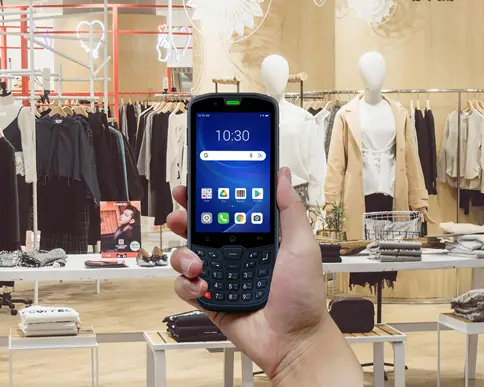Brief Introduction
As a portable device integrating data capture and processing, mobile computers' scanning capability varies significantly depending on technical configurations and operating environments. In this article, we will systematically analyze the key factors affecting scanning range, compare the features of mainstream scanning technologies, and provide practical insights based on industry applications.

I. Factors Affecting the Scanning Range of Mobile Computers
The scanning range of mobile computers is not fixed but influenced by multiple factors, including:
1. Barcode Type
Different barcode types have varying scanning ranges. Generally, 2D barcodes (QR codes) allow longer scanning distances than 1D barcodes due to their higher data capacity and better readability at a distance.
2. Scanner Performance
The quality of the scanner integrated into mobile computers directly affects recognition capability. High-performance laser scanners typically offer superior long-range scanning, especially in low-light conditions.
3. Environmental Conditions
Factors such as lighting, humidity, and dust can impact barcode readability. Strong sunlight or cluttered environments may reduce the effective scanning range.
4. Barcode Print Quality
The clarity and contrast of a barcode are crucial. Blurry, damaged, or low-contrast barcodes are harder to scan, shortening the effective recognition distance.
5. User Operation
The operator's technique also influences scanning success. Keeping a steady hand and adjusting the distance between the device and the barcode properly can improve scanning accuracy.
II. Scanning Technologies in Mobile Computers
Mobile computers primarily use two scanning technologies, each with distinct features and applications:
1. Laser Scanning
The most widely used technology, laser scanners emit a laser beam to read barcodes by analyzing reflected light signals. They offer a longer scanning range (from tens of centimeters to several meters), making them ideal for large-scale scanning applications.
2. Imaging Scanning (2D Scanning)
Also known as 2D barcode scanning, this technology captures barcode images via a built-in camera and decodes them. It supports multiple barcode formats, particularly QR codes, but typically has a shorter scanning range (within tens of centimeters).
III. Scanning Range in Practical Applications
Different industries have varying requirements for mobile computers scanning distances:
1. Logistics & Warehousing
In logistics, mobile computers often need to scan items over larger distances, especially in high-stacking warehouse environments. Laser scanners with extended scanning ranges are essential for improving loading/unloading and inventory management efficiency.
2. Retail
Since retail transactions usually involve close-range scanning, mobile computers do not require extremely long scanning distances. However, high-end stores may use imaging scanners to expedite checkout processes and enhance customer experience.
3. Healthcare
The medical sector demands high accuracy and speed in data capture. Mobile computers must adapt to different scenarios, particularly in mobile nursing and medication management, where reliable scanning helps reduce medical errors.
Founded in 2002, SEUIC Technologies Co., Ltd. has been committed to grasping core technologies, enhancing technological innovation, providing excellent self-owned brand products, including mobile computers, RFID readers, tablets, barcode scanners and fixed readers. With highly reliable products and efficient services, our products have been widely used in manufacturing, retail, logistics & transportation, healthcare and other industries. We provide frontline workers more durable real-time data collection tools, helping you do more thereby to catapult your productivity to the next level.- The Critical Role of Mobile Computers in Warehouse Logistics2025-06-25
- Seuic Mobile Computers: Multi-Scenario Efficiency Solutions2025-06-24
- Operation Guide and Industry Applications of Seuic Mobile Computers2025-06-23
- How to Choose Mobile Computers for Your Industry Needs2025-06-20
- Mobile Computers: The All-in-One Tool from Data Collection to Industry Implementation2025-06-19